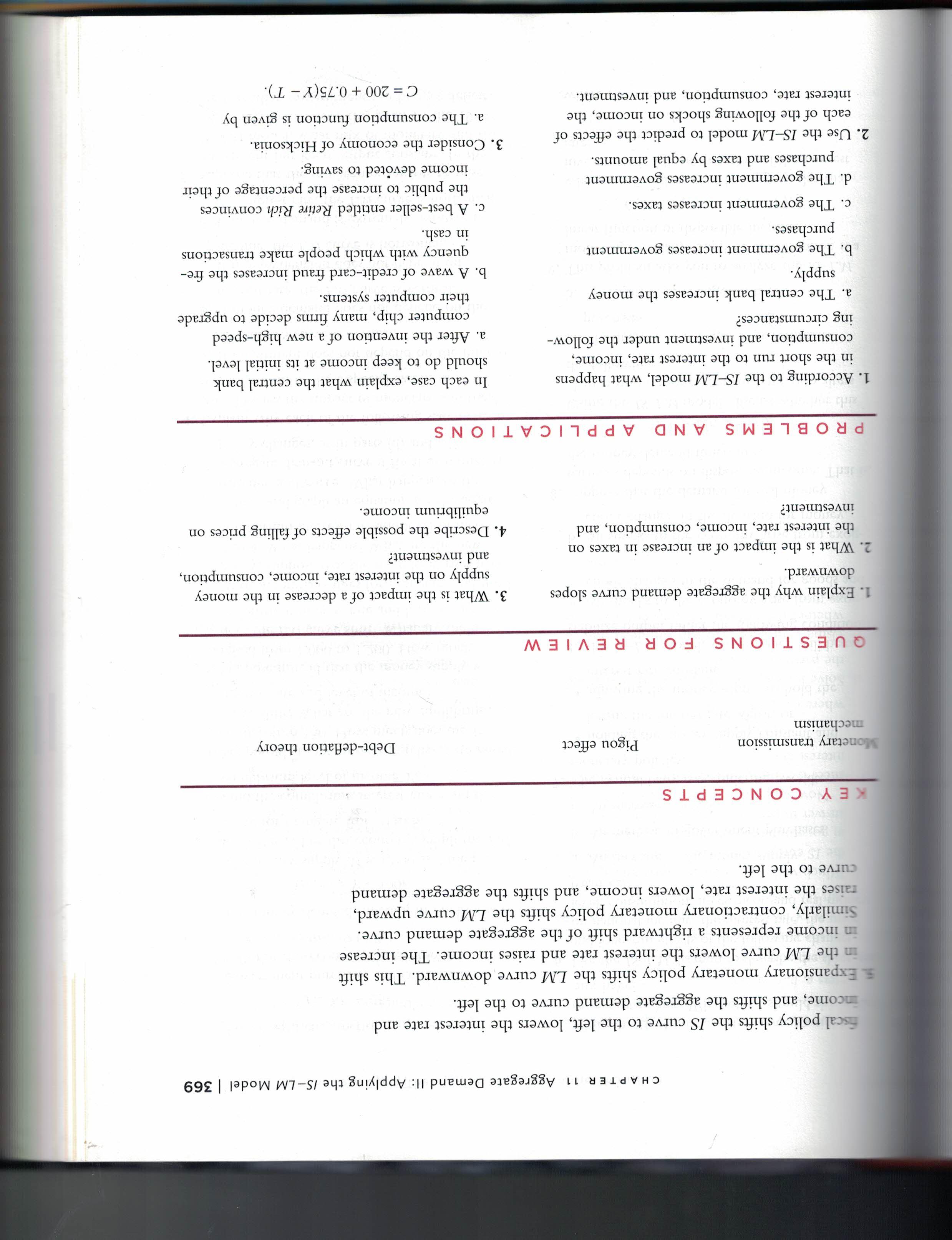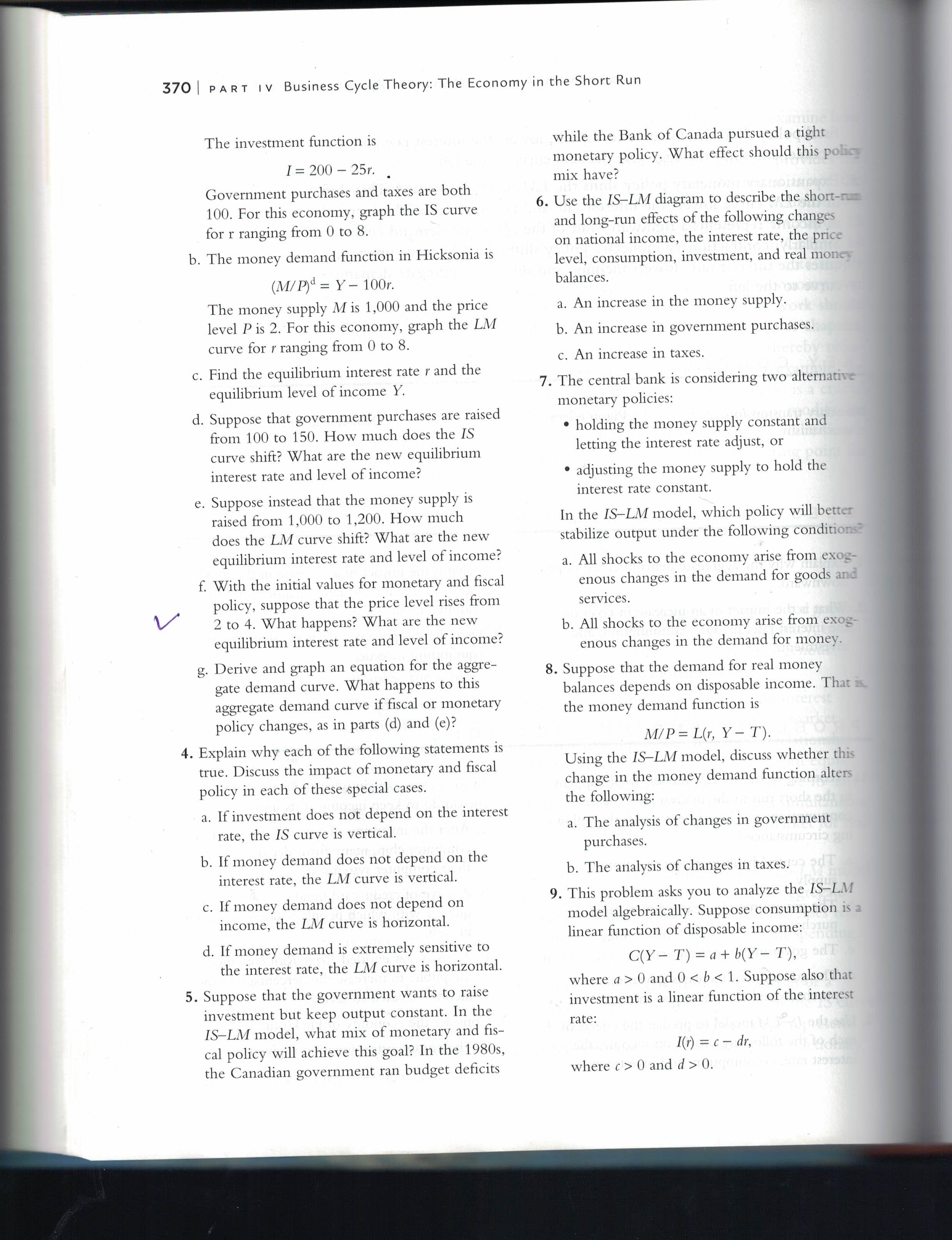question 3 from part a to g
CHAPTER 11 Aggregate Demand II: Applying the IS-LM Model | 369 fiscal policy shifts the IS curve to the left, lowers the interest rate and income, and shifts the aggregate demand curve to the left. Expansionary monetary policy shifts the LM curve downward. This shift in the LM curve lowers the interest rate and raises income. The increase in income represents a rightward shift of the aggregate demand curve Similarly, contractionary monetary policy shifts the LM curve upward, raises the interest rate, lowers income, and shifts the aggregate demand curve to the left. KEY CONCEPTS Monetary transmission Pigou effect Debt-deflation theory mechanism QUESTIONS FOR REVIEW 1. Explain why the aggregate demand curve slopes 3. What is the impact of a decrease in the money downward. supply on the interest rate, income, consumption, 2. What is the impact of an increase in taxes on and investment? the interest rate, income, consumption, and 4. Describe the possible effects of falling prices on investment? equilibrium income. PROBLEMS AND APPLICATIONS 1. According to the IS-LM model, what happens In each case, explain what the central bank in the short run to the interest rate, income, should do to keep income at its initial level. consumption, and investment under the follow- ing circumstances? a. After the invention of a new high-speed computer chip, many firms decide to upgrade a. The central bank increases the money their computer systems. supply. b. A wave of credit-card fraud increases the fre- b. The government increases government quency with which people make transactions purchases. in cash. c. The government increases taxes c. A best-seller entitled Retire Rich convinces d. The government increases government the public to increase the percentage of their purchases and taxes by equal amounts. income devoted to saving. 2. Use the IS-LM model to predict the effects of 3. Consider the economy of Hicksonia. each of the following shocks on income, the a. The consumption function is given by interest rate, consumption, and investment. C = 200 + 0.75(Y - T).370 I P A RT IV Business Cycle Theory: The Economy in the Short Run The investment function is I = 200 251. _ Government purchases and taxes are both 100. For this economy, graph the IS curve for r ranging from 0 to 8. b. The money demand function in Hicksonia is (M/P)d = Y 100r. The money supply TM is 1,000 and the price level P is 2. For this economy, graph the LM curve for r ranging from 0 to 8. c. Find the equilibrium interest rate r and the equilibrium level of income Y. d. Suppose that government purchases are raised from 100 to 150. How much does the IS curve shift? What are the new equilibrium interest rate and level of income? e. Suppose instead that the money supply is raised from 1,000 to 1,200. How much does the LM curve shift? What are the new equilibrium interest rate and level of income? f. With the initial values for monetary and scal policy, suppose that the price level rises from V 2 to 4. What happens? What are the new equilibrium interest rate and level of income? g. Derive and graph an equation for the aggre gate demand curve. What happens to this aggregate demand curve if scal or monetary policy changes, as in parts (d) and (e)? 4. Explain Why each of the following statements is true. Discuss the impact of monetary and scal policy in each of these special cases. a. If investment does not depend on the interest rate, the IS curve is vertical. b. If money demand does not depend on the interest rate, the LM curve is vertical. c. If money demand does not depend on income, the LM curve is horizontal. d. If money demand is extremely sensitive to the interest rate, the LM curve is horizontal. 5. Suppose that the government wants to raise investment but keep output constant. In the ISLM model, what mix of monetary and fis cal policy will achieve this goal? In the 19805, the Canadian government ran budget deficits 6. Use the ISLM diagram to describe the sh while the Bank of Canada pursued a tight {1 monetary policy. What effect should this __ mix have? and longrun effects of the following ch . _ on national income, the interest rate, the p '3' level, consumption, investment, and real o balances. a. An increase in the money supply. b. An increase in government purchases. c. An increase in taxes. 7. The central bank is considering two alte J: j monetary policies: ' ' holding the money supply constant and ' letting the interest rate adjust, or ' ' adjusting the money supply to hold the interest rate constant. In the ISLM model, which policy will b n stabilize output under the following condi r... a. All shocks to the economy arise from > 7 enous changes in the demand for goods services. b. All shocks to the economy arise from ex. " enous changes in the demand for money, 8. Suppose that the demand for real money balances depends on disposable income. Tj the money demand function is 1 M/P=L(r, Y T). , Using the ISLM model, discuss whether i}? change in the money demand function al the following: ' a. The analysis of changes in government purchases. V I b. The analysis of changes in taxes. 9. This problem asks you to analyze the IS model algebraically. Suppose consumption ' linear function of disposable income: C(Y T) = a + b(Y T), Where a > 0 and 0 0 and d > 0








